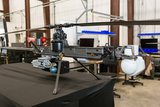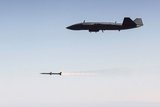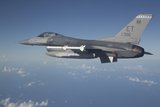DARPA lines up LongShot
DARPA on 8 February awarded three companies preliminary Phase I design contracts on its LongShot programme.
General Atomics, Lockheed Martin, and Northrop Grumman will each work on developing an air-launched UAV capable of employing multiple air-to-air weapons.
LongShot aims to result in a new type of UAV that can ‘significantly extend engagement ranges, increase mission effectiveness, and reduce the risk to manned aircraft’ by allowing them to remain at standoff range far away from enemy threats, DARPA noted.
By demonstrating an unmanned, air-launched vehicle capable of employing current and advanced air-to-air weapons, LongShot ‘changes the paradigm of air combat operations’ and will ‘disrupt traditional incremental weapon improvements’, said DARPA programme manager Lt Col Paul Calhoun.
In later phases of the LongShot programme, a full-scale air-launched demonstration system will be built that will be capable of controlled flight before, during, and after weapon ejection under operational conditions.
As part of our promise to deliver comprehensive coverage to our Defence Insight and Premium News subscribers, our curated defence news content provides the latest industry updates, contract awards and programme milestones.
Related Programmes in Defence Insight
More from Air Warfare
-
![Australia invests extra A$1.4 billion in MQ-28A Ghost Bat after successful missile fire test]()
Australia invests extra A$1.4 billion in MQ-28A Ghost Bat after successful missile fire test
The investment includes new contracts for six MQ-28A Ghost Bat aircraft, as well as provisional funds to invest in the development of a Block 3 prototype.
-
![US approves potential $4.7 billion missile and air defence system sales to Denmark and Italy]()
US approves potential $4.7 billion missile and air defence system sales to Denmark and Italy
Italy could field the JASSM-ER for its combat aircraft including the F-35, while Denmark has been approved for AMRAAM and an Integrated Battle Command system procurement.
-
![Northrop Grumman to fly new Project Talon CCA by late 2026]()
Northrop Grumman to fly new Project Talon CCA by late 2026
The newly unveiled collaborative combat aircraft looks to strike a balance between capability and cost-effectiveness, according to the company.
-
![MBDA and Lockheed move closer to F-35A Meteor flight tests]()
MBDA and Lockheed move closer to F-35A Meteor flight tests
Following the completion of successful ground tests, one more exercise remains before flight testing can begin.























